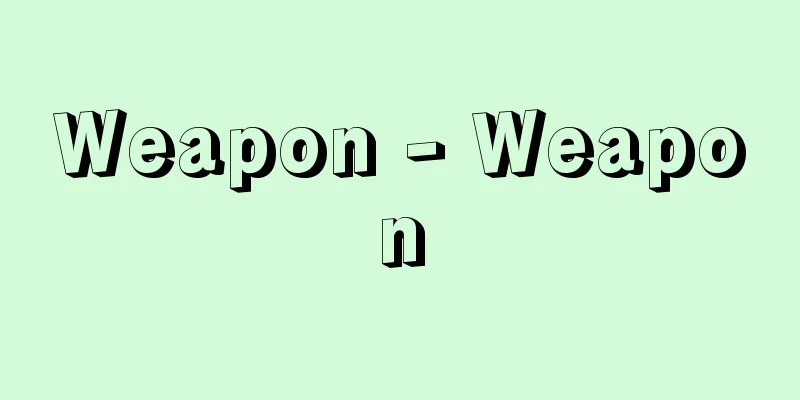Weapon - Weapon

|
A general term for tools used in combat. Generally refers to tools used before the advent of modern weapons. Many of these tools were originally hunting tools and were repurposed for killing humans. They can be classified into nine types based on the type of damage they inflict ( cutting , striking , entangling ) and the manner of use (hand-held, thrown, automatic). Of these, the three main types are swords, spears, and axes that are held in the hand to cut, arrows (bows) that are thrown to cut, and clubs that are held in the hand to strike. Javelin and harpoons that are thrown to cut developed as variations of hand-held cutting tools. Ethnographically, the blowgun (in the humid tropical regions of Asia and America), the boomerang (thrown and struck) and the bola (thrown and entangled) are noteworthy. Some ethnic groups have developed poisoned arrows and javelin throwing devices. Few peoples have developed weapons of other kinds (hand-held entangling nets, various automatic cutting, striking, and entangling traps, and thrown lassoes). Among various weapons, spears were the first to appear in human history. Wooden spears were known from the Early Paleolithic period, and eventually stone points were added to them, and in the Late Paleolithic period, spear throwers appeared. Bows and arrows were rarely used throughout Oceania except Melanesia, and in particular the Australian aborigines did not have bows and arrows, so they only appeared at the stage where spear throwers appeared. Bows and arrows appeared during the transition between the Paleolithic and Neolithic periods. Up until this time, various tools were mainly used for hunting, and rarely used in combat. The tradition of converting hunting tools into weapons was established during the Neolithic period, when combat was frequent in some regions, and from this stage, swords held for cutting and clubs held for hitting began to develop depending on the region. With the appearance of metal tools, swords became longer and larger, and relatively large quantities of projectile weapons with metal points were supplied. In response to increased lethality, defensive metal armor and shields were invented, and a full-fledged weapons culture was established. The oldest fully-fledged weapon culture known to date is the Sumerian period in Mesopotamia. In Mesopotamia, in addition to weapons from before the emergence of urban culture, donkey-drawn chariots with wheels made of two semicircular wooden boards joined together appeared before 3000 BC, and developed into horse-drawn chariots with full-fledged wheels in the early 2nd millennium BC. In the 1st millennium BC, wall breakers were added. The West Asian weapon complex, including horse-drawn chariots, is a cultural element common to the continental cultures of Eurasia, including South Asia, and regional and periodic characteristics were added. For example, in Greece and Rome, heavy infantry with swords, shields, and spears were the main force, and the development of slings was a characteristic. Until the development of firearms in the 14th century AD, heavy infantry and crossbows were characteristic of the European weapon complex. The development of plate armor in the 13th and 14th centuries is also part of this tradition. In Asia from the B.C. onwards, cavalry using short bows and stirrups equipped with curved swords was considered the main fighting force. In East Asia, bronze weapons (swords, halberds, pikes, shields, armor, and chariots) developed significantly over the course of the first millennium after the middle of the 2nd millennium BC. With the spread of iron, this tradition came to an end, and a weapon complex was created in which the long sword and the whistling horn were given special significance, and similar trends began to appear in other parts of Asia after the Christian era. The Japanese tradition of weapons developed from imported and domestically produced bronze weapon-shaped products and their temporary combinations, but until around the 10th century, they were of little practical use, and full-scale development did not occur until the mid-Heian period, when bamboo archery bows began to spread. Swords were a distinctive development, and each period produced many master swordsmiths. The 14th century was a turning point in Japan's weapon culture, as it gradually changed from the traditional horseback archery battles equipped with armor and helmets to mass infantry battles equipped with swords, spears, and modern armor. In the 16th century, imported firearms began to completely transform the weapon complex, but this transformation stopped midway as weapons lost their practical use with the establishment of control by the Edo Shogunate. There are few customs related to technologically advanced swords and other weapons in folk ceremonies, and many are archery rituals related to the Tsuina ritual, which originated in the Shurai. [Akira Sasaki] Weapons from the perspective of primitive technological historyLet us go back to the very origins and consider how humanity acquired the weapons mentioned above from the perspective of the history of primitive technology. The origins of weapons are very ancient. It can be said that they began with the birth of mankind. However, it is thought that the earliest weapons were not the kind that were later used in combat between humans, but were for fighting carnivorous animals. Animals similar to humans appeared on the African continent around 3 to 4 million years ago. However, they were weak animals, and this weakness is deeply related to the origin of weapons. Known as Homo habilis (a type of ape-man), they were already walking upright on two legs and are thought to have been using simple tools on a daily basis. The tools they used were tree branches, stones, animal horns and bones, some of which were processed. Homo habilis was thought to have been about the size of today's chimpanzees, but its body shape was different from that of chimpanzees. Its legs were longer than its arms, and it walked on just two legs. Its arms were thinner, shorter and weaker than those of chimpanzees. Its teeth were merely small like those of today's humans, and its canines were not fangs like those of chimpanzees. Given this body structure, it is easy to imagine that it had inferior fighting abilities as an animal, and in fact it was weak. Let's think about fighting ability in terms of offensive and defensive capabilities. As mentioned above, humans at that time were inferior to carnivores in terms of offensive capabilities, but they were also inferior in terms of defensive capabilities. Their running ability was not particularly good, and their skin was thin. If they were attacked by a carnivorous animal, they would not have stood a chance. For these reasons, it is thought that they avoided situations where they had to fight other animals as much as possible, but when they were forced to fight, they probably fought with tools to compensate for their weaknesses. However, their fights with carnivores were not fights to ultimately win, but temporary fights to escape from the animals. The tools used in such temporary fights to protect themselves - likely nothing more than sticks or stones - are thought to have been the first weapons. On the other hand, humans at that time seem to have hunted small animals such as hares and mice. When hunting, they probably used sticks, stones, and bones as tools. And the tools used for hunting were gradually improved over a long period of time. It is believed that sharpened sticks (the origin of spears) began to be used at a relatively early stage. Around the same time, sharp knife-like tools made from split bones and chipped stone tools are thought to have been made. In some areas, knives made from shells may have also existed. How long did this period last? Eventually, humans acquired fire. At the latest, by the time of Homo erectus (early humans), hundreds of thousands of years ago, humans had begun to use fire on a daily basis. Fire was thought to be the best way to ward off wild animals, a defensive weapon. But before long, they began to use fire for attack. Using fire and various other tools, humans developed techniques for hunting animals of all sizes, eventually transforming into one of the strongest animals on earth. During this time, more effective use of tools, such as methods for throwing stones, spears, and sticks, were invented and improved. During the time of Archaic humans (Neanderthals), it is believed that the technology for throwing bolas, which are stones tied to strings, and spears, as well as tools like boomerangs, began to be invented. The technology for making fire may have also been discovered. They may have also learned to apply poison to the tips of spears. During the modern human stage (a Cro-Magnon group), hunting tools and techniques were further developed, with the appearance of slings and spear-throwing devices. It is believed that these tools and techniques eventually came to be used as weapons for fighting between humans. [Masao Iwaki] "The World History of Weapons and Tactics" by Tsuneki Kaneko (1979, Hara Shobo) " ▽ "Weapons" edited by Diagram Group, translated by Yuichi Tajima et al. (1982, Marl Publishing) ▽ "The Theory of Primitive Technology" by Masao Iwaki (1985, Shinsei Publishing) [References] | | | | |Source: Shogakukan Encyclopedia Nipponica About Encyclopedia Nipponica Information | Legend |
|
戦闘に用いる器具の総称。一般には近代兵器出現以前の器具をさす。狩猟用具から人間殺傷用に転用した器具が多い。相手に与える損傷の種類(切る、たたく、絡ませる)と使用の様態(手に持つ、飛ばす、自動)とにより、9種類に分類できる。このうち、手に持って切る刀剣・槍(やり)・斧(おの)、飛ばせて切る(弓)矢、手に持ってたたく棍棒(こんぼう)の三つが主要であった。飛ばせて切る投槍・銛(もり)の類は手にもって切る用具の変形として発達した。民族誌的には、吹き矢(アジア・アメリカの湿潤熱帯)、飛ばせてたたくブーメラン(オーストラリア)、飛ばせて絡ませるボーラ(南アメリカ草原地帯)が注目される。毒矢、投槍(とうそう)器などを発達させた民族もある。このほかの種類(手に持って絡ませる網、自動的に切る・たたく・絡ませる各種のわな、飛ばせて絡ませる投縄(なげなわ))の武器を発達させた民族は少ない。 各種の武器のうち人類史上もっとも早く出現したのは槍類で、前期旧石器時代から木製の槍が知られ、やがて石製尖頭(せんとう)器(槍先)をつけ、さらに後期旧石器時代には投槍器が出現した。メラネシアを除くオセアニア全域では、弓矢の使用が少なく、とくにオーストラリア先住民には弓矢がなく、ほぼ投槍器出現段階にとどまった。旧・新石器時代移行期には弓矢が出現した。この時期までの各種用具は主として狩猟用で、戦闘に用いるのはまれだったとみられる。狩猟用具を武器に転用する伝統が確立したのは、地域により戦闘が多発した新石器時代からであり、この段階から地域により手に持って切る刀剣と、手に持ってたたく棍棒(こんぼう)が発達しはじめた。金属器が出現すると刀剣類が長大化し、金属製尖頭器をつけた飛ばす武器が比較的大量に供給された。殺傷能力の向上に対し、防御用の金属製装甲・盾類が発明され、本格的な武器の文化が成立した。 これまでに判明している最古の本格的な武器文化の成立は、メソポタミアのシュメール期である。メソポタミアでは都市文化出現以前からの武器群に加えて、紀元前3000年以前に半円形木板を二つあわせた車輪をもつロバの引く戦車が出現し、前2000年紀初頭には馬の引く本格的車輪をもつ戦車に発展した。前1000年紀には城壁破砕器が加わった。馬の引く戦車を含む西アジア型の武器複合は南アジアを含むユーラシアの大陸諸文化に共通の文化要素であり、地域的、時期的な特色が加わった。たとえば、ギリシア・ローマでは剣、盾、槍をもつ重装歩兵が主力であり、投石器の発達が特徴的だった。紀元後14世紀からの銃砲の発達まで、重装歩兵と弩(ど)(いしゆみ)とがヨーロッパの武器複合の特徴だった。13、14世紀のプレート・アーマー(全身を覆う甲冑(かっちゅう))の発達もこの伝統の一部である。紀元前以降のアジアでは、短弓、曲刀装備の鐙(あぶみ)を用いた騎兵が主戦力と考えられた。 東アジアでは、前2000年紀中葉以降の1000年間に青銅製武器(刀剣、矛(ほこ)、戈(か)、盾、甲冑、戦車)が目だって発達した。鉄の普及によりこの伝統は終わり、一時的に大刀、鳴鏑(なりかぶら)に特別な意味をもたせた武器複合が生じ、紀元後はアジアの他地域でも同様の傾向が生じた。 日本の武器の伝統は、輸入・国産の武器形青銅製品とその一時的な複合とを出発点として発達したが、ほぼ10世紀ごろまでは、実用性は低く、本格的に発展したのは、竹製の合わせ弓が普及し始めた平安中期以降であった。特徴的な発達がみられたのは刀であり、各時期に名刀工を輩出した。 14世紀が日本の武器文化の変換点で、それまでの鎧(よろい)・兜(かぶと)を装備した一騎駆けの騎射戦から、しだいに刀・槍・当世具足を装備した集団歩兵戦へと変化した。16世紀には外来の銃砲が武器複合を全面的に変化させ始めたが、江戸幕府による支配の確立により、武器の実用性が消滅したので、この変化は中途で停止した。民俗行事には、技術的に発達した刀剣類に関連する慣行は少なく、『周礼(しゅらい)』起源の追儺(ついな)儀礼に関連する弓神事が多い。 [佐々木明] 原始技術史からみた武器前述のような武器を人類がどのように獲得したか、その原初に立ち戻って原始技術史の側面から考えてみる。 武器の起源は非常に古い。それは人類の誕生とともに始まったといってもよい。ただし当初の武器は、のちに人間同士の戦闘で用いたようなものではなく、肉食獣と闘うものであったと考えられる。人類らしい動物は300万~400万年ぐらい以前、アフリカ大陸に出現した。しかし彼らは弱い動物であり、その弱さが武器の起源と深く関係した。 ホモ・ハビリス(猿人の一種)とよばれる彼らは、すでに直立二足歩行をし、しかも簡単な道具類を日常的に使用して生活していたと考えられる。道具の種類は、木の枝、石、動物の角(つの)や骨などで、一部は加工されていた。ホモ・ハビリスは今日のチンパンジー程度の大きさであったと考えられるが、体型はチンパンジーとは異なっていた。足が手より長く、2本の足だけで歩行した。腕はチンパンジーより細く、短く、力も弱かった。歯並びは今日の人間のように小さな歯にすぎず、犬歯はチンパンジーのような牙(きば)ではなかった。このような身体の構造からみて、動物としての闘う能力が劣ったものであることは容易に想像され、実際にも弱かった。 闘う能力を、攻撃力と防御力に分けて考えてみる。当時の人類は前述のように攻撃力で肉食獣などに劣っていたが、防御力の点でも同様に劣っていた。走る能力がそれほど優れているわけではなく、皮膚も薄かった。肉食獣などに襲われた場合、ひとたまりもなかったであろう。こうしたことから他の動物などと闘うような状態はできる限り避けたと考えられるが、やむなく闘う場合には自らの弱点を補うものとしての道具を手にして闘ったと思われる。とはいっても肉食獣などに対する闘いは、彼らが最終的に勝利するための闘いではなく、獣から逃げ去るための一時的な闘いであった。そうした身を守るための一時的な闘いに使われた道具――ただの棒切れや石ころにすぎなかったであろう――が、武器としての最初のものであったと思われる。 一方、当時の人類はノウサギやノネズミなどの小動物を狩猟していたらしい。狩猟の場合にも、棒切れ、石、骨などを道具として使ったと思われる。そしてそれらの狩猟のための道具も長い期間にしだいに改良されていった。 棒の先を鋭くとがらせたもの(槍(やり)の始まり)は比較的早い時期から使われ始めたと推定される。それと前後して、骨を割った鋭いナイフの類の道具や打製石器もつくられるようになったと考えられる。地域によっては貝殻を利用したナイフの類も存在したとも考えられる。 そうした時代がどれほど続いたであろうか。やがて人類は火を獲得した。遅くとも数十万年以前のホモ・エレクトゥス(原人)の時代には火を日常的に扱うようになっていた。火は猛獣を避けるための最良の手段、つまり防御用の武器であったと考えられる。しかし、やがて彼らは火を攻撃に使うようになっていった。 人類は火およびそのほかのさまざまな道具を駆使して、大小さまざまな動物を狩猟する技術を発展させ、ついに地上における最強の動物の一種に変貌(へんぼう)していった。 その間、道具をより効果的に使うこと、たとえば石や槍、棒を投げる方法もくふう・改良された。旧人(ネアンデルタール人の仲間)の時代には石に紐(ひも)を結び付けて投げるボーラや槍投げの技術、またブーメランのような道具もくふうされ始めたと思われる。火をつくる技術も発見されたかもしれない。槍の先に毒を塗ることも知ったかもしれない。 新人(クロマニョン人の仲間)の段階になると、狩猟具・狩猟技術はさらに発達し、投石器や投槍(とうそう)器などが出現する。そしてそれらの狩猟具や狩猟技術が、やがて人間同士が闘うための道具、すなわち武器として使われるようになったと考えられる。 [岩城正夫] 『金子常規著『兵器と戦術の世界史』(1979・原書房)』▽『ダイヤグラムグループ編、田島優一他訳『武器』(1982・マール社)』▽『岩城正夫著『原始技術論』(1985・新生出版)』 [参照項目] | | | | |出典 小学館 日本大百科全書(ニッポニカ)日本大百科全書(ニッポニカ)について 情報 | 凡例 |
Recommend
Sanseki - Sanseki
A name given to three calligraphers of the Heian ...
mycelium
…The branched, thin filamentous bodies that make ...
Hanawa basin - Hanawabonchi
A graben basin in the upper reaches of the Yonesh...
Cotton padding - Wataire
It is a garment with cotton between the outer and...
Elro Furnace - Elro
Indirect arc furnaces are generally used in place...
Kumano [town] - Kumano
A town in Aki District, southern Hiroshima Prefect...
Coexistence magazine - Kyosonzasshi
…After Ono returned to Japan, a similar group was...
Marshal's Office
The highest military advisor to the Emperor. It w...
Kano School - Kanoha
The largest school of painting in the history of ...
Notoplana humilus (English spelling) Notoplanahumilus
...The planarian Dugesia japonica lives under sto...
Darwinism - Darwinism
This term refers to C. R. Darwin's theory of ...
Independence aircraft carrier
A Forrestal-class conventional aircraft carrier of...
Sangha (English spelling)
A Sanskrit word meaning "group," "g...
Kyoto Calendar - Kyoto Calendar
…It is also called the Kyoto calendar. It is a ca...
Jade Emperor - Yu-huang da-di
The supreme deity of Taoism. In Taoism, Yuanshi Ti...









